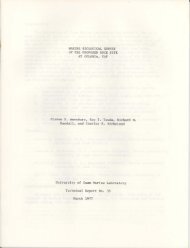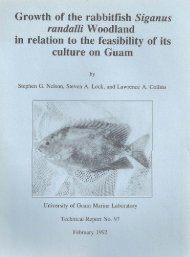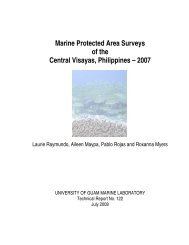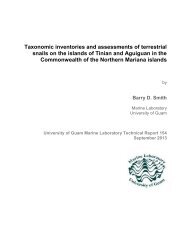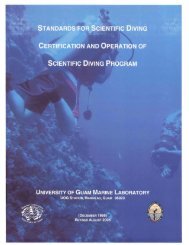survey of the shallow-water sea cucumbers of the central philippines
survey of the shallow-water sea cucumbers of the central philippines
survey of the shallow-water sea cucumbers of the central philippines
You also want an ePaper? Increase the reach of your titles
YUMPU automatically turns print PDFs into web optimized ePapers that Google loves.
only able to locate two <strong>of</strong> his specimens, nei<strong>the</strong>r identified as types: a specimen <strong>of</strong> A.<br />
carolineana labeled as “Holothuria sp.” and a specimen <strong>of</strong> H. canaliculata identified as<br />
“Holothuria (Mertensiothuria) canaliculata.” His o<strong>the</strong>r material appears, <strong>the</strong>refore, to be<br />
lost, though, it is possible that his type material was deposited at <strong>the</strong> National Museum <strong>of</strong><br />
<strong>the</strong> Philippines.<br />
Summary and proposed work<br />
In one month <strong>of</strong> collecting, at least 40 species <strong>of</strong> <strong>sea</strong> <strong>cucumbers</strong> were found by <strong>the</strong><br />
re<strong>sea</strong>rch team. The team also examined photographs <strong>of</strong> <strong>sea</strong> <strong>cucumbers</strong> taken by several<br />
biologists and divers who reside in <strong>the</strong> Philippines or have made extensive trips to <strong>the</strong><br />
region. A few <strong>of</strong> <strong>the</strong>ir species were not found during this <strong>survey</strong>. Several <strong>of</strong> <strong>the</strong>se appear<br />
to be new species or <strong>of</strong> uncertain taxonomic status. Thus, it would be useful to continue<br />
<strong>the</strong> <strong>survey</strong>s in <strong>the</strong> Visayan Islands in hopes <strong>of</strong> collecting <strong>the</strong>se important missing species.<br />
Future efforts would probably be concentrated on <strong>the</strong> extensive reef flat, <strong>sea</strong>grass beds<br />
and adjacent forereef slopes <strong>of</strong> Panglao Island in sou<strong>the</strong>rn Bohol where <strong>the</strong> greatest<br />
number <strong>of</strong> interesting finds was encountered.<br />
Acknowledgements<br />
The re<strong>sea</strong>rch team thanks <strong>the</strong> U.S. National Science Foundation, Silliman University-<br />
Angelo King Center for Re<strong>sea</strong>rch and Environmental Management, Silliman University<br />
Marine Laboratory and <strong>the</strong> Coastal Conservation and Education Foundation, Inc.<br />
for logistical support and local collaboration; <strong>the</strong> Bantay Dagat groups <strong>of</strong> Agan-an,<br />
Poblacion, Masaplod Norte, Masaplod Sur, Apo Is., Hilutungan, Basdiot, Saavedra,<br />
Zaragosa and Balicasag Marine Protected Areas, and <strong>the</strong> managers <strong>of</strong> <strong>the</strong> Nalusu-an<br />
MPA, for <strong>the</strong>ir invitation and support; and <strong>the</strong> Local Governments <strong>of</strong> Dumaguete City<br />
and Dauin, Negros Oriental; and Moalboal and Badian, western Cebu for allowing <strong>the</strong><br />
team access to <strong>the</strong>ir marine protected areas.<br />
8





